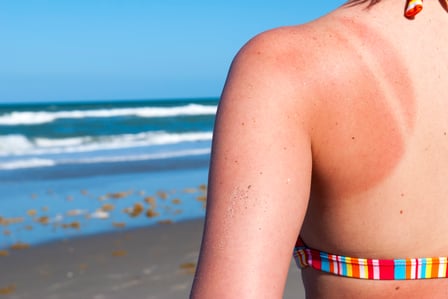What's so bad about sunburn?
What’s so bad about sunburn? In the short-term, it causes pain, redness and discomfort, but this quickly fades and leaves many of us with a glowing tan. So what is sunburn and why is it so bad? Why should you avoid it and what should you do if you’ve accidentally spent too long in the sun? How can you find some relief and prevent it from happening again? Let’s cover all this and more.
While the short-term effects of sunburn might seem trivial, it’s more the long-term impact you need to worry about. Sunburn causes permanent damage to your skin cells, accelerating skin ageing and causing potentially deadly skin cancers like melanoma.
Did you know: Just 5 sunburns doubles your melanoma risk.
What is sunburn?
Sunburn is the skin’s inflammatory reaction to ultraviolet (UV) radiation from the sun. Melanin – the pigment which gives skin its colour and defends it from UV rays – darkens to protect sun-exposed skin. The amount of melanin you produce is determined by genetics, which is why some people sunburn while others tan. However, both are signs of cellular damage to the skin.
Sunburn can range from a tanned complexion to a red burn, through to blistering and peeling. This peeling is your body’s way of shedding the damaged cells.

Some things you should know…
Some people are more prone to sunburn than others. For example, people with fair skin are at greater risk. But anyone can get sunburnt; no one is immune to sunburn and its harmful effects.
Even if you don’t burn, sun exposure raises your skin cancer risk. Even people with tanned or darker complexions can get skin cancer. Even if your skin doesn’t redden when you go out in the sun, the UV rays can still cause cellular damage that leads to skin cancer.
You can get sunburn anytime, anywhere. The sun’s UV levels vary depending on the time of day, the season and the location. A high UV index means you will burn faster or more severely. UV can’t be seen or felt – it’s different from the sun’s light or heat – so it’s important to check the UV index in your weather forecast every day. UV levels can still be high on cool or cloudy days and this is often how people get accidentally burnt: you simply don’t think of the damaging impact of the sun when you can’t see or feel it!
All sunburn is bad. No matter how mild, every tan or burn you get is a sign of permanent injury that can lead to skin ageing and cancer.
Sunburn prevention
You can check out handy tips for protecting your skin on our blog.
Sunburn and skin cancer risk
Fair-skinned people are at higher risk of sunburn and skin cancer because their skin lacks the protective pigment melanin. Repeated sunburns raise your risk of skin cancer; in fact, just one blistering sunburn in childhood or adolescence is enough to double your chance of developing melanoma later in life, and five or more sunburns in your entire lifetime also doubles your risk.
UV damage can also occur even if you can’t see the burn. Sun damage builds up over time, so the more you burn, the greater your risk of skin cancer. People who are exposed to the sun nearly every day – through work or play – therefore have a very high risk of skin cancer.
What to do if you get sunburnt
Read our blog to find some relief if you’ve accidentally gotten too much sun.
The take-away
When you get sunburnt, your skin will heal but the real damage has already been done on a deeper level. Repeated sunburns put you at high risk for skin cancer and skin ageing, so protect yourself every day and make a commitment to looking after your skin health.
- Tags:
